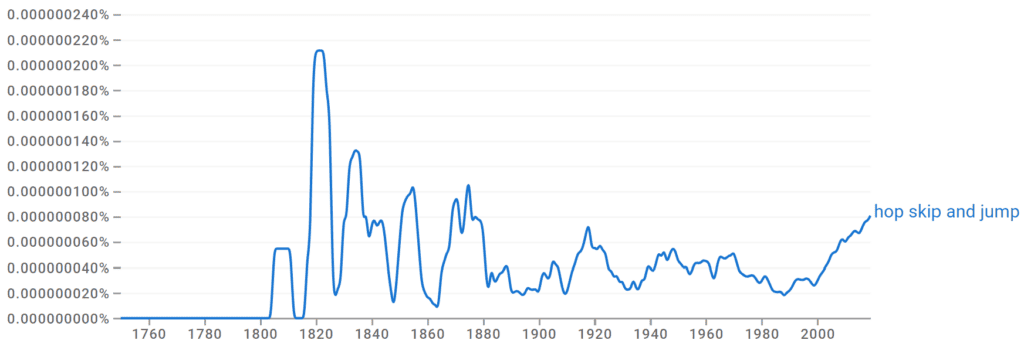A hop, skip, and a jump means that a destination or task is relatively close or easy to reach. Think about it this way: if you were flying from New York to Boston, cities that are quite near to each other, you might describe the journey as just “a hop, skip, and a jump” away.
This idiom is a playful way to convey proximity or simplicity. Idioms, like this one, play a crucial role in enriching our language, giving color and depth to our conversations. They don’t just convey literal meanings but capture cultural nuances, emotions, and historical contexts. Delving deeper into the English language, mastering idioms will certainly level up your linguistic prowess.
Curious about the origins of a hop, skip, and jump? Well, its roots trace back to the 1800s, evolving in meaning over the years. Dive into the article to discover more examples and to get a grasp on how to seamlessly weave this idiom into your daily chats and musings.
What Is the Meaning of Hop, Skip, and Jump?
A hop, skip, and a jump is a playful way of saying something is really close or just a short distance away. It paints an image of someone lightly and effortlessly hopping, skipping, and then jumping—a series of actions that take mere moments and cover a short distance. It’s one of the many idioms that make the English language colorful and rich in imagery.
For example:
- When booking a one-way flight, Chicago is only a hop, skip, and a jump away from Detroit.
- If you use the walkway across the tennis courts, it makes getting to the main campus a simple hop, skip, and a jump.
- Our rental property is only a hop, skip, and a jump to the beach when walking.
- No need to fret about getting to the station on time; it’s literally a hop, skip, and jump away from here!
- I just moved to a new apartment, and the best part is that the coffee shop I love is just a hop, skip, and jump away.
Is It “a hop, skip, and jump” or “a hop, skip, and a jump?
Both “a hop, skip, and jump” and “a hop, skip, and a jump” are used, but the more common and traditionally accepted version is “a hop, skip, and a jump.” The extra “a” gives each action its own emphasis, painting a more vivid picture of the three distinct movements. However, language is always evolving, and both versions are understood to mean the same thing—a short distance or a brief effort. Depending on the context and personal preference, one might opt for one version over the other.
Hop, Skip, and Jump Origins
The idiom “hop, skip, and a jump” has roots that are easy to trace. Each word in the phrase has been around since at least the 1500s, with distinct meanings. For instance, “hop” was used to describe a small jump back then, and by the early 1700s, it had taken on a fun twist, referring to an informal dance party. Even today, “hop” can conjure images of a casual dance, more laid-back than a grand ball.
Interestingly, by 1719, the trio “hop, step, and jump” was linked to a dance move. This evolved into “hop, skip, and jump” by the 1760s. Fast forward to 1909, and the phrase took on a different flavor. It was used to describe short aircraft flights during an era when daredevils and innovators were pushing the boundaries of aviation. Today, this sense of the term, implying a short distance, is the most commonly embraced meaning.
Let’s Review
Idioms, like a hop, skip, and a jump, are fascinating. On their own, the words might point to simple actions or even dance moves, like “hop.” But when strung together, they paint a whole new picture. While in the 18th century, this phrase might’ve made you think of dance steps, today, it’s all about describing a short distance. That’s the beauty of language – it evolves, and so do its expressions.
Check out some others we covered:


